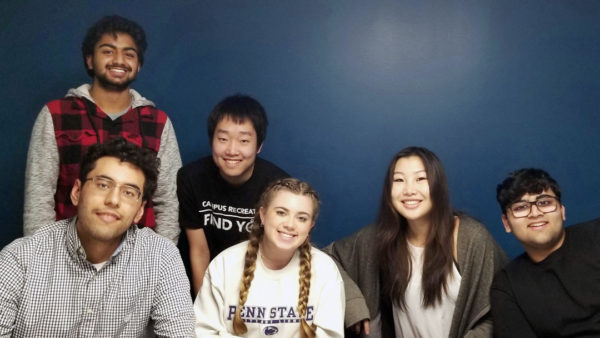
Leslie Wubbel, Anikate Ganju, and Brittnie Yi, the team behind the creation of Vessel, are passionate about using computer and data sciences to ignite a change in the medical scene of CT scans and radiology. Through their participation in the Nittany AI Challenge, they are striving to create a minimal viable product to showcase the research they’ve endeavored at Penn State. The team’s primary goal is to use pixel classification to distinguish vessels in slices of CT scans.
As an integral tool for research, pixel classification involves a computer looking at a range of grayscale pixels. Statistics then aids the computer in forming groups (classes) based on frequency of pixel shades within a CT scan. These scans are split into hundreds of individual slices, and computed tomography (CT) helps researchers and radiologists make an overview of scans to detect objects within the human body. In Vessel’s case, the team uses pixel classification to process sections or “patches” of an image into a function, detecting where visible vessels lie in a certain tissue. Pixel classification allows the team to segment images from foregrounds, backgrounds, etc. to distinguish vessels from tissues.
Through a thorough examination of these “slices” of images, the team strives to create a Convolutional Neural Network (CNN) model that automatically searches through these images and segments data or “features” out to recreate a three-dimensional vasculature model. Scientists can then use this model to examine processes such as fluid property mechanics and more easily diagnose ailments within tissue. The technology the team is creating will be able to offer space for comparison from an afflicted organ to a normal one. They will work with open-source datasets, such as the Ferdowsi University of Mashhad’s PE dataset (FUMPE), to create a prototype model for their objective. FUMPE includes hundreds of CT scan “slices” from over thirty patients with pulmonary embolism, including anonymous patient data. The team will transform the data and segment it within the CNN model to conduct automatic vessel segmentation, generating 3D blood vessel models.
Future applications for this model are integral to predicting vessel branch patterns that are not currently visible on today’s CT scans. Using Machine Learning to interpret pixels and identify patterns allows scientists and doctors to efficiently detect unseen objects within these scans. This technology could especially aid the artificial tissue growing industry, as a more concrete understanding of vascular structure could produce more viable human and animal tissues.
The Vessel team:
Driven by times of adversity, emotion, and the banality of college life, Leslie yearned to create something big that could leave a mark on this large university, where many simply get lost in the crowd. His love of art, nature, and fractals inspired him to search for detail, gain outside perspectives, and analyze depth in the world around us. Knowledge of fractals and biotechnology especially inspired him to create a solution to a currently unsolvable problem in detecting fine vasculature within the human body. He is currently a senior pursuing a biotechnology degree.
Anikate has enjoyed creating and bringing imaginative ideas to life; he hopes that some of these ideas will come to fruition in future entrepreneurship. An avid risk taker, he strives to break societal norms in becoming more innovative to differentiate himself from other students. He feels that his own self-discipline and will to learn excels beyond what college offers, as his own motivation has aided his studies more than most professors. As a junior pursuing a data science engineering degree, Anikate hopes to use his skills in artificial intelligence and machine learning to make advancements in the field of image segmentation. He also enjoys creating professional networks and is the head of the team’s public relations branch.
Another team member, Brittnie Yi, joined the team to gain more real-world data science and artificial intelligence experience. She is excited to be more involved and committed to research at Penn State and works with the team’s data analysis and project management. Olivia Sarkisian is also on the team for document editing, video editing, and marketing purposes, in order to gain technical editing experience in the area of artificial intelligence. An undecided freshman, Eric Liu sees the Nittany AI challenge as a method of exploring possibilities in coding and artificial intelligence at Penn State. Providing an initial proposal for the challenge that did not get accepted, he met Leslie and decided to join the team to research and network. Rishyak Pinchal hopes to take his initial interest in biology and channel it to advance the field through artificial intelligence. He is a sophomore pursuing computer science and wants to apply what he’s learned so far to develop a useful product in a real-life situation. He is also interested in politics and will be doing work for the team’s technical and public relations sectors. Vessel is excited to undertake the Nittany AI Challenge and create a product that is truly meaningful; they hope to represent the team, Penn State, and the field of artificial intelligence in a positive light.
